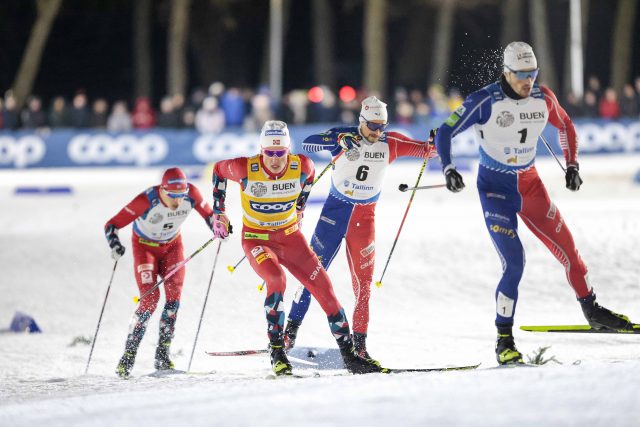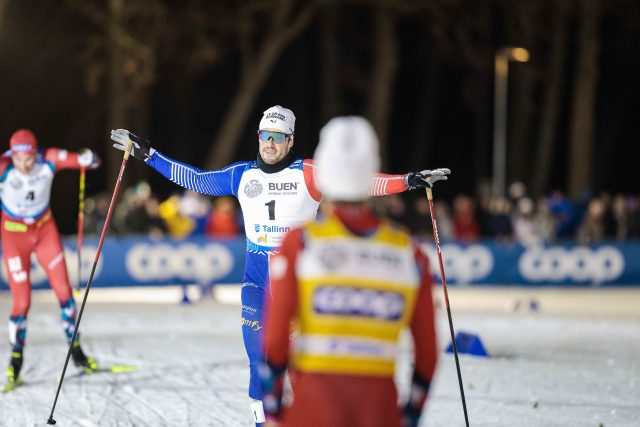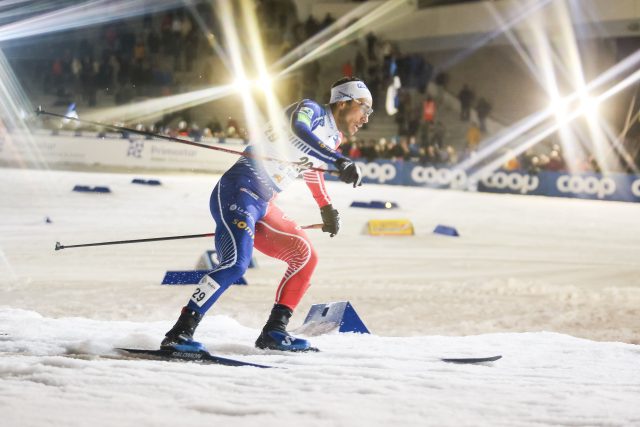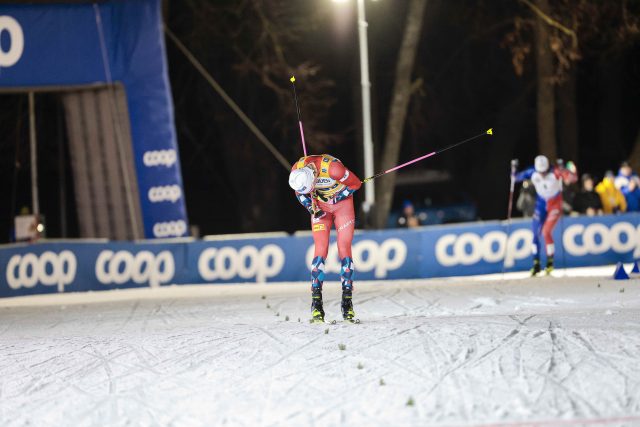 This World Cup coverage is made possible through the generous support of Marty and Kathy Hall and A Hall Mark of Excellence Award. To learn more about A Hall Mark of Excellence Award, or to learn how you can support FasterSkier’s coverage, please contact info@fasterskier.com.
This World Cup coverage is made possible through the generous support of Marty and Kathy Hall and A Hall Mark of Excellence Award. To learn more about A Hall Mark of Excellence Award, or to learn how you can support FasterSkier’s coverage, please contact info@fasterskier.com.

All things being equal—including the wax—it appears that the fastest skier is still the fastest skier. Johannes Hoesflot Klaebo’s (NOR) performance in today’s FIS World Cup Freestyle Sprint certainly proved that any perceived Norwegian “wax advantage” is not the only reason why Klaebo continues to dominate week after week. Under the shadowy, vaporous glow of course-lighting in Tallin, Estonia—where FIS rules had been amended to insure that all competitors enjoyed equal waxing conditions—Klaebo ran away from the field in much the same fashion he always does. Fastest skis, deepest fitness, highest speeds, most refined technique, most innovative tactics: the rest of the world couldn’t beat him last week, and this week was no different.
Lucas Chanavat (FRA) carried his usual tactics (take the lead, set the pace) to a second place finish, followed by Even Northug (NOR) in third. North American skiers never seemed to find the right racing form as Ben Ogden (USA) was the only North American qualifier (11th). He would struggle to keep pace with the winners of his quarterfinal, and finished the day in 13th.
Podium awards were presented by President Alar Karis, head of state of the Republic of Estonia. When’s the last time World Cup awards were presented by a head of state? Perhaps it’s a reflection of the impassioned fan base that cross country skiing enjoys in Estonia (a nation that has produced many World and Olympic champions including Kristina Šmigun-Vähi and Andrus Veerpalu).
Wax Protocol
The great respect afforded the awarding of prizes wasn’t the only thing that made this World Cup stop unique. FIS had announced long ago that this particular World Cup event would be governed by a new set of waxing protocols in which all competitors’ skis would be waxed by a single entity (in this case, Swix). Skiers would use their own skis, and team technicians would be allowed to apply structure, but all glide wax would be precisely the same. Broadcast announcers suggested that Swix is the sponsor of this wax-restricted event; certainly, that singular sponsorship may eventually be questioned as an unfriendly way to treat all other wax manufacturers, while also illuminating the difficulties inherent in staging any effort to “equalize” wax advantages.
Many American junior race-regions are already governed by equality-seeking wax protocols (with race organizers announcing the glide wax days before races so that all competitors can prepare skis ahead of time). It’s a system that has inspired both proponents and detractors, with much of the criticism stemming from the ability of some skiers to acquire faster skis and or more sophisticated base-grinds. If any skier in the world would have access to the best skis available, it would be Klaebo. Maybe he proved that today . . . or maybe he just proved that he really is the fastest skier. Race commentator, Kikkan Randall described the thinking behind the move as the FIS wanting to “see if eliminating the wax factor can bring the field a little closer.” If race officials were thinking that the leader board could be reshuffled by this new wax protocol, they would exit the experiment disappointed. Klaebo really is the best skier . . . maybe even by a wider margin this week than in those weeks when Norwegian wax techs are free to apply their most secretive voodoo.

Men’s Freestyle Sprint
Race organizers brought in tons and tons of snow in order to create Tallinn’s two lap sprint course. The result was deep, soft snow that accumulated in the corners where course marshals attempted to rake and reconfigure rutted surfaces between heats; no one really knew what racing conditions any given corner might deliver. Is the fastest line one that follow the tracks of earlier skiers (where a racer could find their line irrevocably altered), or is the fastest line one to the outside in untracked snow, where a racer could find themselves bogged down in soft snow? There were no reliable predictions . . . other than the fact that Klaebo was likely to be the one who handled it all the best.
“This feels like a home course,” Klaebo said in post-race interviews. “My grandpa lives here in Tallinn, and it’s special to have him here watching me as well.”
And what’s more miraculous? The fact that Klaebo wins so many sprints? Or the fact that Klaebo qualifies for so many finals? What he accomplishes week after week is a set of racing feats that no other competitor shows the ability to do with any regularity at all. We just expect to see him in the final—and so he appears in the final. We just expect him to win—and so he wins. It’s as though Klaebo possesses the ability to watch his own races from above: he never chooses to accelerate at the wrong time, he never chooses to commit to the too-tight line, he never finds himself pinched or cut off or tangled or needing to scrub speed at an inopportune moment. Klaebo doesn’t seem interested in the shortest line or the most direct line . . . Klaebo appears far more interested in maintaining the most speed. That way, when he finally enters the finishing straight, he already has more speed than anyone else (especially on a course like Tallinn’s that offers a very short finishing straight after a tight turn). Klaebo was able to give himself room to follow a wide line around the last turn each and every time. Carry speed, stay out of trouble, sprint to the line. Maybe other racers should begin watching what he does . . . or maybe that wouldn’t make a difference, either. Maybe he’s just plain faster. Today, that was certainly the case . . .

Many regular contenders would struggle with the deep, soft conditions. Richard Jouve (FRA) looked particularly out of sorts in his quarterfinal heat, while Federico Pellegrino struggled through the tight turns and steep climbs in a manner that would not typically be his norm. As for Klaebo, he may be the most capable close-quarters ski racer in the world. He never gets tangled, never gets taken down. He seems to have an innate ability to continue accelerating even when he is busy avoiding other tips, tail, poles. Even when he tangled with Bolshunov in that infamous finishing straightaway of the 2021 World Championship 50k, it was Bolshunov who tumbled, not Klaebo.
In the final, Klaebo again appeared happy to follow Chanavat—who obligingly went straight to the front of the field at the crack of the starter’s pistol. It seemed that the final would follow the pattern of both quarterfinal and semifinal, but at least one racer knew that would leave him on the outside looking in. Edvin Anger (SWE) drove up along Klaebo’s flank on the significant climb; that’s all the motivation Klaebo seemed to need. Seeming to dislike the clogging and in-fighting that was being inspired by Anger’s accelerations, Klaebo simply jumped away up the main climb, establishing a gap that no others could bridge. Having given himself an insumountable lead, Klaebo had enough time to wave to the crowd for the final 150 meters. Chanavat carried his own momentum across the line in second while Northug managed to out-lunge Anger for third.
Maybe FIS’ wax protocols made a difference; maybe they didn’t. What does remain evident is that Klaebo is the best sprinter no matter who does the waxing.
Men’s Freestyle Sprint RESULTS

John Teaford
John Teaford—the Managing Editor of FasterSkier — has been the coach of Olympians, World Champions, and World Record Holders in six sports: Nordic skiing, speedskating, road cycling, track cycling, mountain biking, triathlon. In his long career as a writer/filmmaker, he spent many seasons as Director of Warren Miller’s annual feature film, and Producer of adventure documentary films for Discovery, ESPN, Disney, National Geographic, and NBC Sports.



